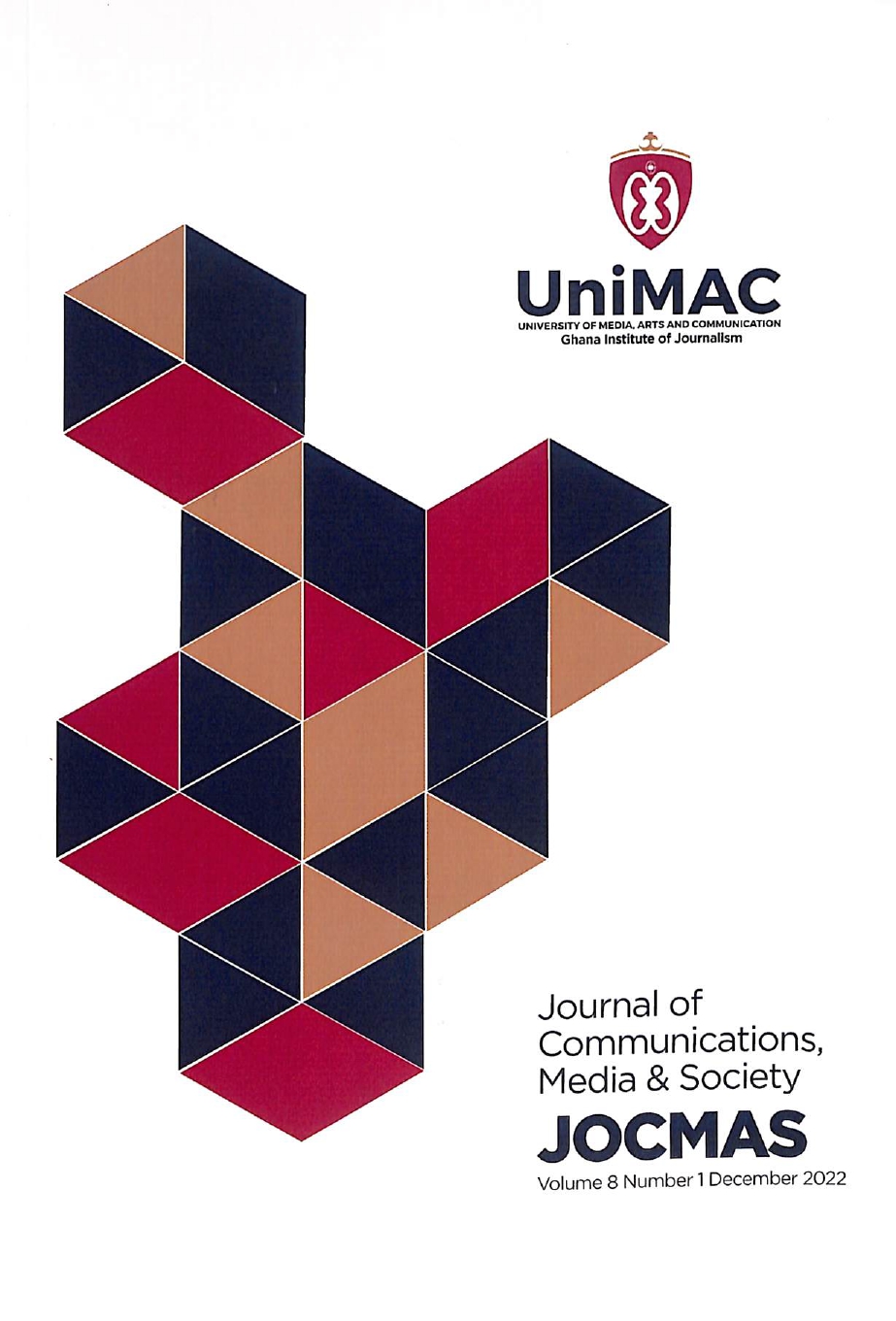Blogging as an e-Learning Tool in Tertiary Communication Institutions in Ghana: An Exploratory Study
DOI:
https://doi.org/10.63772/jocmas.v5n1.1Keywords:
Blogging, E-Learning Tool, Tertiary Communication Institutions, Ghana, Exploratory StudyAbstract
This study investigated blogging as an e-learning tool and the level at which it is becoming a medium for teaching and learning in communication tertiary institutions in Ghana. The study considered four theories; e-learning/online learning models; constructivism, interactivism, and connectivism to provide a context for the use of instructional technology, focusing on communication training institutions in Ghana. Using a quantitative methodology, the study adopted multi-stage sampling procedure to respond to three propositions: 1. Students who have blog sites are more comfortable with lecturers who use blogging as an e-learning tool for teaching and learning. 2. There is a significant positive relationship between students with blog sites and Communication training institutions that consider e-learning as a teaching and learning platform. 3. Having a blog site influences the career development of students from Communication training institutions. Findings were that; tutors and learners casually use e-learning tools, majority of students and lecturers in communication training institutions in Ghana would appreciate utilising e-learning tools for the delivery of various learning modules, but it is sparingly, casually and occasionally used. The study also provided a new model within the context of active patronage of e-learning tools and blogging for teaching and learning in tertiary institutions in Ghana.
Downloads
Usage Statistics
- Abstract Views: 194
- PDF Downloads: 70
References
Addo, H. (2001). Utilizing information and communication technology for education and development: Issues and challenges for developing countries. IFLA Journal, 24(3), 143–153. DOI: https://doi.org/10.1177/034003520102700306
Alfonso, & de Valbuena, M. (2006, as cited in James, M. 2006). A review of the impact of new media on public relations: Challenges for terrain, practice and education. Asia Pacific Public Relations Journal, 8. Australia.
Anderson, T. (2004). Getting the mix right again: An updated and theoretical rationale for interaction. The International Review of Research in Open and Distributed Learning. Retrieved August 20, 2017, from http://www.irrodl.org/index.php/irrodl/article/view/149/230
Ashraf, D., & Lakhtaria, K. I. (2011). The impact of the new Web 2.0 technologies in communication, development, and revolutions of societies. Journal of Advances in Information Technology, 2(4), 204–216. DOI: https://doi.org/10.4304/jait.2.4.204-216
Ball, D. L., Thames, M. H., & Phelps, G. (2008). Content knowledge for teaching: What makes it special? Retrieved August 10, 2017, from http://conferences.illinoisstate.edu/NSA/papers/ThamesPhelps.pdf
Bonk, C. J., & Reynolds, T. H. (1997). Learner-centered web instruction for higher-order thinking, teamwork, and apprenticeship. In B. H. Khan (Ed.), Web-based instruction (pp. 167–178). Englewood Cliffs, NJ: Educational Technology Publications.
Cohen, L., Manion, L., & Morrison, K. (2011). Research methods in education (7th ed.). London: Taylor and Francis Group.
Dewdney, A., & Ride, P. (2006). The new media handbook. London: Routledge. DOI: https://doi.org/10.4324/9780203645789
Ferdig, E., & Trammell, K. D. (2004). Content delivery in the ‘Blogosphere’. T.H.E. Journal Online, Technological Horizons in Education, 31(7), 12–18.
Glasersfeld, V. E. (1989). Cognition, construction of knowledge and teaching. Synthese, 80(1), 121–140. https://doi.org/10.1007/BF00869951 DOI: https://doi.org/10.1007/BF00869951
Gotts, A. (2006). Blogging at the chalkface. The Knowledge Tree: e-Journal of Learning Innovation. Retrieved August 1, 2017, from http://kt.flexiblelearning.net.au/tkt2006/edition-11-editorial/bloggingat-the-chalkface
Hargittai, E. (2003). The digital divide and what to do about it. Retrieved August 1, 2017, from http://www.eszter.com/research/pubs/hargittai-digitaldivide.pdf
Hawkins, R. J. (2002). Ten lessons for education in the developing world: World Links for Development program. The World Bank Institute. Retrieved August 9, 2017, from http://unpan1.un.org/intradoc/groups/public/documents/apcity/unpan008676.pdf
Huffaker, D. (2004). The educated blogger: Using weblogs to promote literacy in the classroom. First Monday, 9(6–7). Retrieved May 2, 2017, from http://firstmonday.org/ojs/index.php/fm/article/view/1156/1076 DOI: https://doi.org/10.5210/fm.v9i6.1156
Kitchen, P., & Burgmann, I. (2004). Integrated marketing communications. Retrieved October 9, 2017, from https://doi.org/10.1002/9781444316568.wiem04001 DOI: https://doi.org/10.1002/9781444316568.wiem04001
Liaw, S. S., & Huang, H. M. (2000). Enhancing interactivity in web-based instruction: A review of the literature. Educational Technology, 40(3), 4–45.
Mangesi, K. (2007). Survey of ICT and education in Africa: Ghana country report. infoDev. Retrieved September 12, 2017, from http://www.infodev.org DOI: https://doi.org/10.1596/10708
Marfo, J. S., & Okine, R. K. (2011). Implementation of e-learning in Ghanaian tertiary institutions: A case study of Kwame Nkrumah University of Science and Technology (KNUST), Kumasi. Retrieved June 11, 2017, from http://hdl.handle.net/123456789/1433
Mishra, P., & Koehler, M. J. (2006). Technological pedagogical content knowledge: A framework for teacher knowledge. Teachers College Record, 108(6), 1017–1054. DOI: https://doi.org/10.1177/016146810610800610
Shulman, L. (1986). Domains: Pedagogical content knowledge. Retrieved August 4, 2017, from http://www.leeshulman.net/domainspedagogical-content-knowledge.html
Siemens, G. (2014). Theory of connectivity as an emergent solution to innovative learning strategies. Retrieved August 4, 2017, from http://pubs.sciepub.com/education/2/2/7/ DOI: https://doi.org/10.12691/education-2-2-7
Simatwa, E. M. W. (2010). Piaget’s theory of intellectual development and its implication for instructional management at pre-secondary school level. Educational Research and Reviews, 5(7), 366–371. Retrieved August 4, 2017, from http://www.academicjournals.org/ERR2
Vaill, P. B. (1996). Learning as a way of being. San Francisco, CA: Jossey-Bass Inc. Retrieved September 10, 2017, from http://www.elearnspace.org/Articles/connectivism.htm
van Dijk, A. G. M. J. (2006). The network society (2nd ed.). London: Sage Publications Ltd.
Ventimiglia, P., & Pullman, G. (2016). From written to digital: New literacies. EDUCAUSE Review, 2. Retrieved July 4, 2017, from http://er.educause.edu/~/media/files/articles/2016/3/erm1623.pdf
Vester, M. (2010). A social media toolkit for the journalism classroom. Rhodes Journalism.
Wang, Q. (2008). A generic model for guiding the integration of ICT into teaching and learning. Innovations in Education and Teaching International, 45(4), 411–419. DOI: https://doi.org/10.1080/14703290802377307
Wasserman, H. (2010). Teaching critical global journalism. Retrieved August 4, 2017, from http://journals.co.za/docserver/fulltext/rujr/2010/30/rujr_n30_a14.pdf
Downloads
Published
Issue
Section
License
Copyright (c) 2025 Journal of Communications, Media And Society (JOCMAS)

This work is licensed under a Creative Commons Attribution-NonCommercial 4.0 International License.








